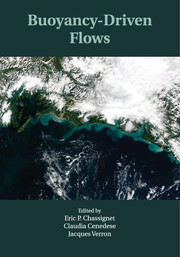Book contents
- Frontmatter
- Contents
- List of Contributors
- Introduction
- 1 Gravity currents – theory and laboratory experiments
- 2 Theory of oceanic buoyancy-driven flows
- 3 Buoyancy-forced circulation and downwelling in marginal seas
- 4 Buoyant coastal currents
- 5 Overflows and convectively driven flows
- 6 An ocean climate modeling perspective on buoyancy-driven flows
- 7 Buoyancy-driven currents in eddying ocean models
- 8 Atmospheric buoyancy-driven flows
- 9 Volcanic flows
- 10 Gravity flow on steep slope
- Index
- Plate section
- References
1 - Gravity currents – theory and laboratory experiments
Published online by Cambridge University Press: 05 April 2012
- Frontmatter
- Contents
- List of Contributors
- Introduction
- 1 Gravity currents – theory and laboratory experiments
- 2 Theory of oceanic buoyancy-driven flows
- 3 Buoyancy-forced circulation and downwelling in marginal seas
- 4 Buoyant coastal currents
- 5 Overflows and convectively driven flows
- 6 An ocean climate modeling perspective on buoyancy-driven flows
- 7 Buoyancy-driven currents in eddying ocean models
- 8 Atmospheric buoyancy-driven flows
- 9 Volcanic flows
- 10 Gravity flow on steep slope
- Index
- Plate section
- References
Summary
Introduction
Gravity currents occur when there are horizontal variations in density in a fluid under the action of a gravitational field. Asimple example that can be readily experienced is the gravity current that flows into a warm house through a doorway when it is opened on a cold, windless day. The larger density of the cold air produces a higher pressure on the outside of the doorway than on the inside, and this pressure difference drives the cold air in at the bottom and the warm air out at the top of the doorway. In addition to horizontal density variations, there must also be some feature to stop the fluid from either rising or falling indefinitely and to constrain the flow to be primarily horizontal. In many cases this is a solid boundary, such as the ground. In other situations it may be another feature of the density variations within the fluid, such as a density interface or vertical density stratification.
Gravity currents occur in gases when there are temperature differences, such as in the sea breeze, the flow of cool moist air from the sea to the land. On a warm day, the sun heats the land more than the sea, and, consequently, the air at low altitudes over the land is warmer than that over the sea. The sea breeze is a significant feature of coastal meteorology in many parts of the world.
- Type
- Chapter
- Information
- Buoyancy-Driven Flows , pp. 13 - 51Publisher: Cambridge University PressPrint publication year: 2012
References
- 13
- Cited by



